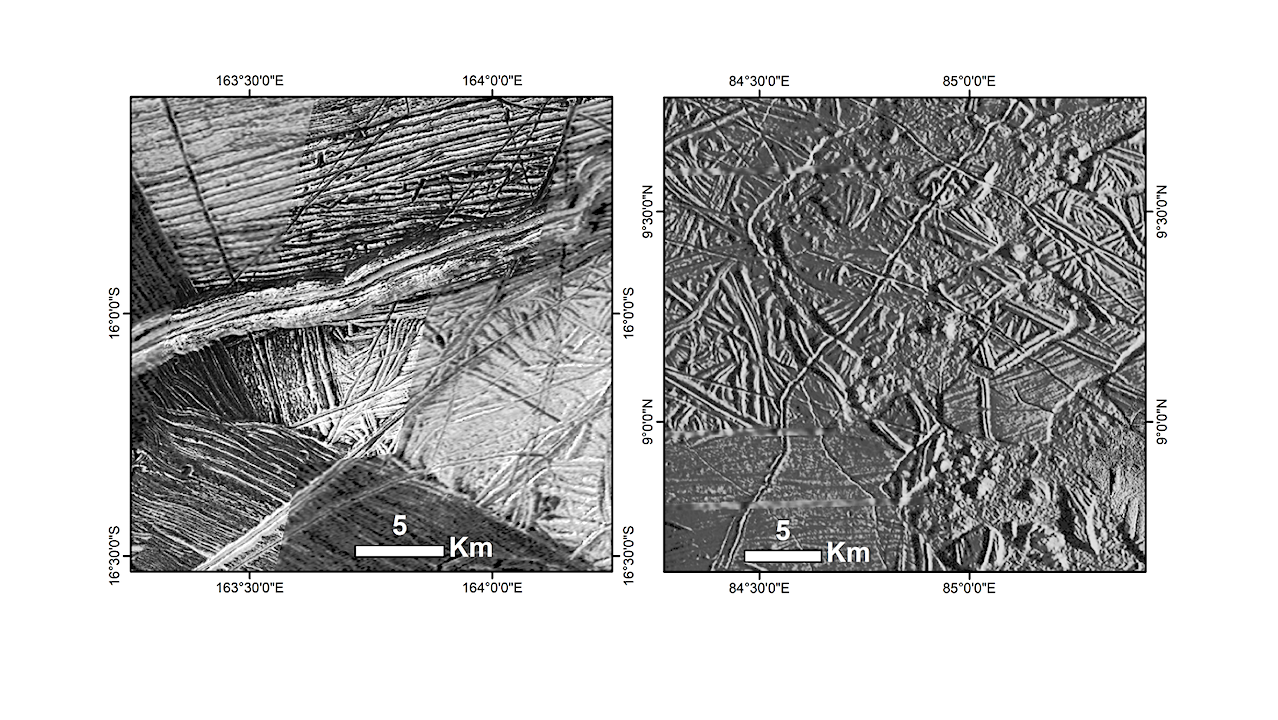Meta is overhauling Facebook Reels with major updates designed to bring it closer to the Instagram experience. The company is refining how users discover, share, and engage with short videos, all while enhancing personalization through smarter…
Author: admin
-

OpenAI no longer forced to save deleted chats—but some users still affected
Moving forward, all of the deleted and temporary chats that were previously saved under the preservation order will continue to be accessible to news plaintiffs, who are looking for examples of outputs infringing their…
Continue Reading
-

CPI inflation report will be released by Labor Department, while other data is delayed by shutdown
A large US flag is seen on the facade of the Department of Labor headquarters building in Washington DC, United States on September 8, 2025.
Celal Gunes | Anadolu | Getty Images
The Labor Department will bring back staff to work on a key consumer inflation report despite the ongoing federal government shutdown, CNBC has learned.
The department’s Bureau of Labor Statistics will “promptly resume” work on September’s Consumer Price Index data, a White House official said. The report will come out at 8:30 a.m. ET on Oct. 24, nine days after it was originally scheduled, according to the BLS.
The department had originally paused work on the CPI report – which tracks a broad basket of goods and services for price changes over time — due to its shutdown plan, the official said. But the Social Security Agency needs third-quarter CPI data for calculating and publishing annual cost-of-living adjustments before Nov. 1.
Other BLS data releases including the nonfarm payroll report haven’t been published as originally intended since the federal government shutdown due to a lapse in funding. The Senate on Thursday failed to pass funding bills for the seventh time that would have ended the closure, which began last week.
Bloomberg News first reported that the BLS was calling employees back to work on CPI data.
— CNBC’s Steve Liesman contributed to this report.
Continue Reading
-

Group of leading international banks explores issuance of a 1:1 reserve-backed form of digital money
Leader in banking and financial services in Europe, BNP Paribas operates in 64 countries and has nearly 178,000 employees, including more than 144,000 in Europe. The Group has key positions in its three main fields of activity: Commercial, Personal Banking & Services for the Group’s commercial & personal banking and several specialised businesses including BNP Paribas Personal Finance and Arval; Investment & Protection Services for savings, investment and protection solutions; and Corporate & Institutional Banking, focused on corporate and institutional clients. Based on its strong diversified and integrated model, the Group helps all its clients (individuals, community associations, entrepreneurs, SMEs, corporates and institutional clients) to realise their projects through solutions spanning financing, investment, savings and protection insurance. In Europe, BNP Paribas has four domestic markets: Belgium, France, Italy and Luxembourg. The Group is rolling out its integrated commercial & personal banking model across several Mediterranean countries, Türkiye, and Eastern Europe. As a key player in international banking, the Group has leading platforms and business lines in Europe, a strong presence in the Americas as well as a solid and fast-growing business in Asia-Pacific. BNP Paribas has implemented a Corporate Social Responsibility approach in all its activities, enabling it to contribute to the construction of a sustainable future, while ensuring the Group’s performance and stability.
Continue Reading
-

Hippos Lived In Europe During Last Ice Age
Hippos, today restricted to sub-Saharan Africa, survived in central Europe far longer than previously assumed. Analyses of bone finds demonstrate that hippos inhabited the Upper Rhine Graben sometime between approximately 47,000 and…
Continue Reading
-
Milano Cortina 2026 tells its story at Festival dello Sport di Trento
Statements from the key actors
During the panel discussion, key topics were addressed, such as the importance of an organisational model that can adapt to new challenges, the central role of volunteers and the strong participation of the younger…
Continue Reading
-

How confident are Americans in doing practical tasks?
(timnewman/Getty Images) Most Americans express confidence in their ability to do various practical tasks, according to a recent Pew Research Center survey.
The survey asked Americans if they felt they could do each of 12 activities, ranging from everyday household tasks to ones that require more technical knowledge.
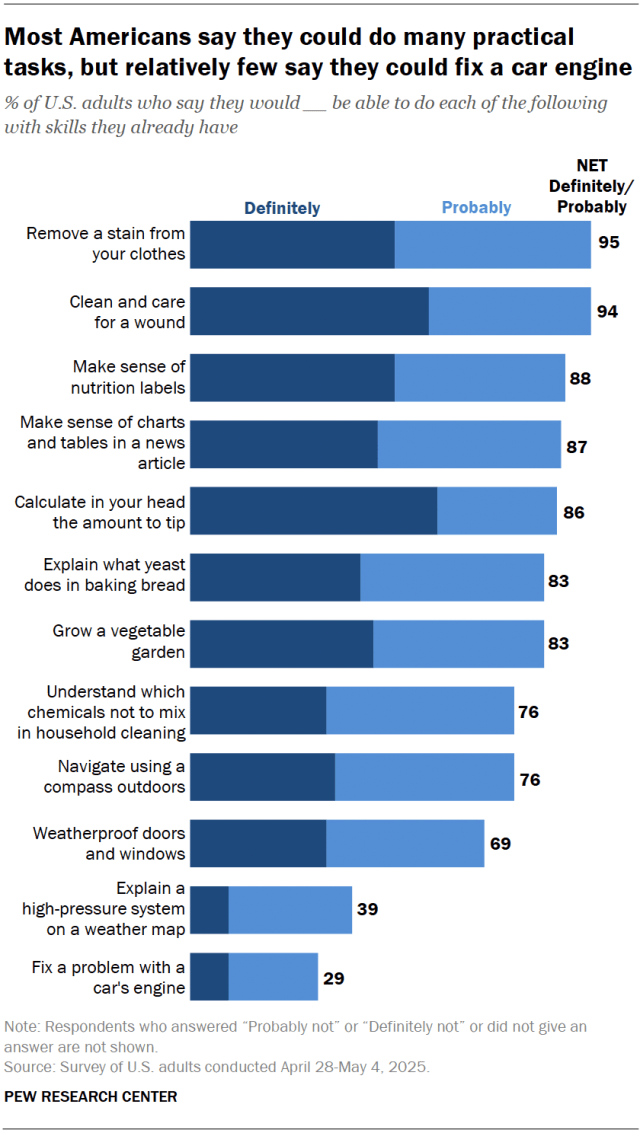
Most Americans say they can do certain tasks related to health and food:
- 94% of U.S. adults say they definitely or probably would be able to clean and care for a wound.
- 88% say they would be able to make sense of nutrition labels.
- 83% say they could explain what yeast does in baking bread.
- 83% say they could grow a vegetable garden.
Most Americans also are confident in their ability to do certain household tasks:
- 95% of adults say they definitely or probably would be able to remove a stain from their clothes.
- 76% say they would understand which chemicals not to mix in household cleaning.
- 69% say they would be able to weatherproof doors and windows.
Most Americans also say they definitely or probably would be able to understand charts and tables in a news article (87%), calculate the amount to tip in their head (86%) or navigate using a compass (76%).
Americans are much less confident in their ability to do other tasks that require more specialized knowledge. Fewer than half say they definitely or probably would be able to explain a high-pressure system on a weather map (39%) or fix a problem with a car’s engine (29%).
How confidence varies by education
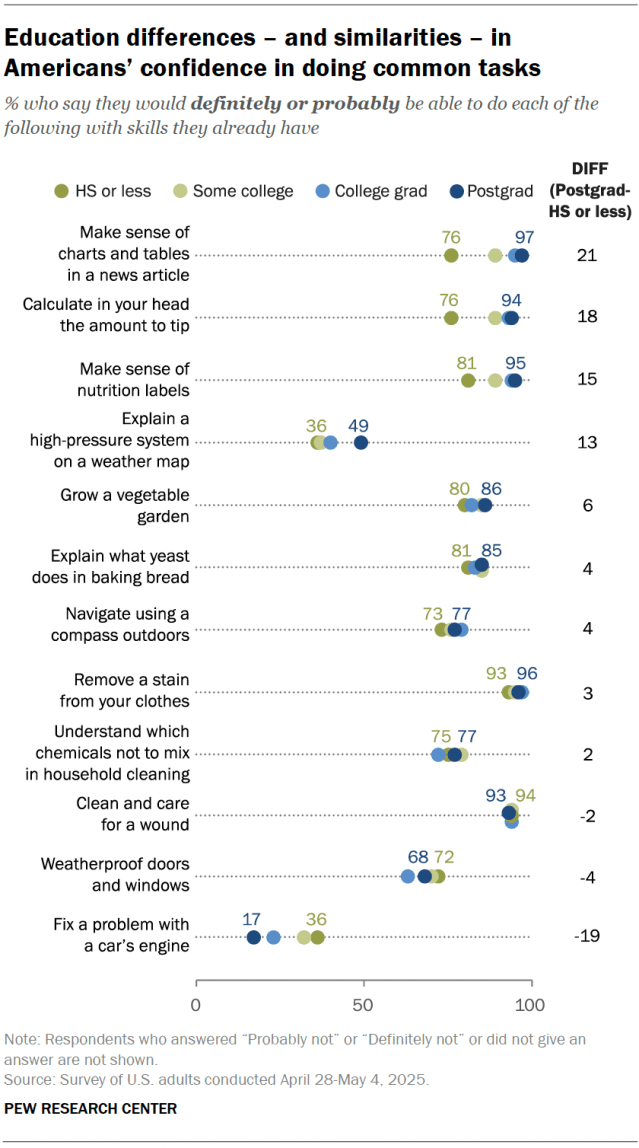
Americans with more education are more likely than those with less education to say they would be able to make sense of numerical information and do math in their head. Still, large majorities across all educational groups say they would be able to do these things.
The pattern is reversed when it comes to fixing a problem with a car’s engine: Americans without a college degree are more likely than those with a degree to say they definitely or probably would be able to do this.
How confidence varies by gender
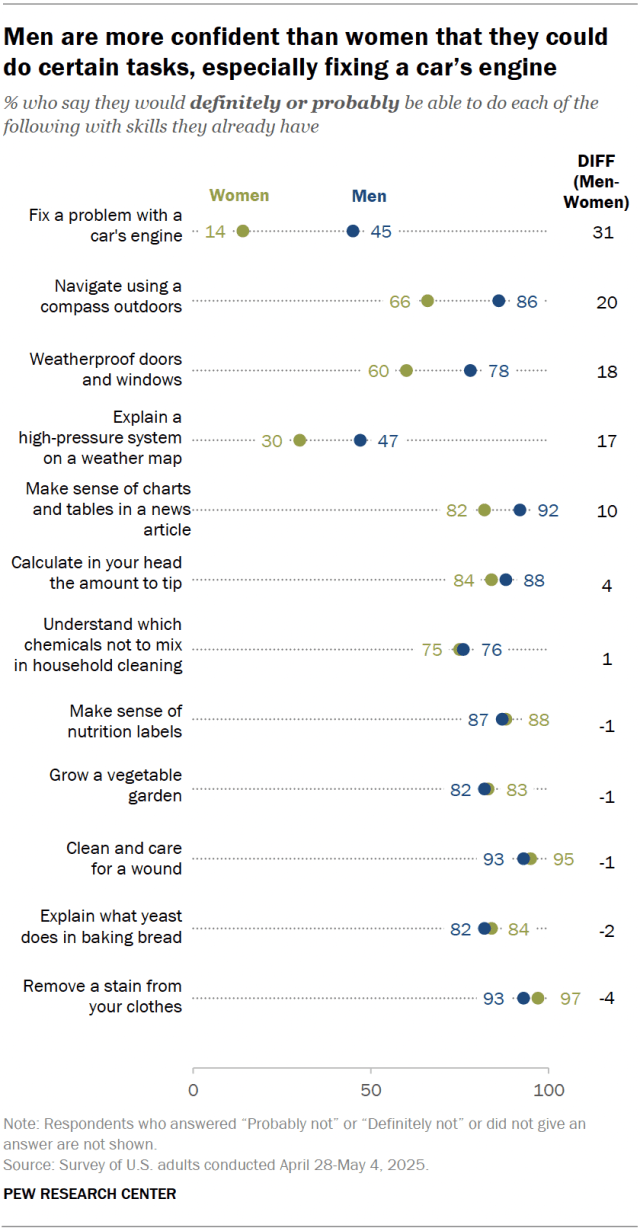
Men and women often take on different roles in households and practical tasks. And men are more likely than women to say they would be able to do some of the tasks we asked about.
- The largest gender gap concerns fixing a car’s engine: 45% of men say they definitely or probably would be able to do this, compared with 14% of women.
- Men are also much more likely than women to say they’d be able to navigate using a compass outdoors (86% vs. 66%), weatherproof doors and windows (78% vs. 60%), and explain a high-pressure system on a weather map (47% vs. 30%).
- There are only small gender differences in other tasks we asked about. For example, similar majorities of men and women say they would be able to calculate the amount to tip in their head or make sense of nutrition labels.
How confidence varies by age
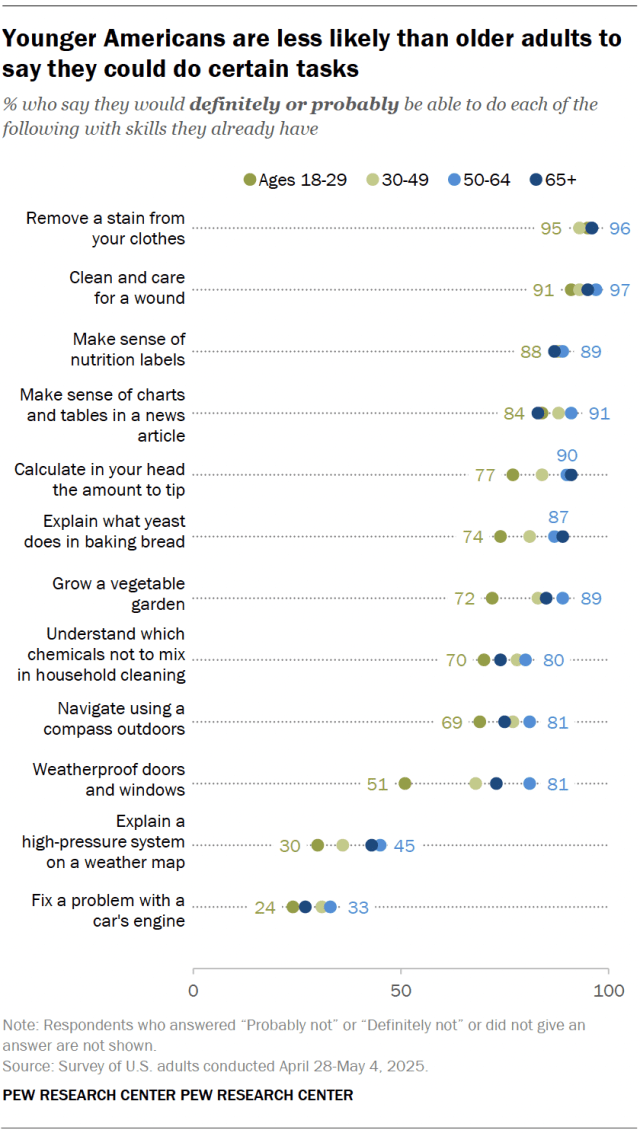
Majorities of younger adults say they could do most of the tasks we asked about – though sometimes at lower rates than older Americans.
For example, 51% of adults under 30 say they definitely or probably would be able to weatherproof doors and windows, compared with much larger shares of older adults.
Also, 77% of adults under 30 say they would be able to calculate a tip in their head, compared with nine-in-ten ages 50 and older.
Related: Tipping Culture in America: Public Sees a Changed Landscape
Note: Here are the questions used for this analysis, the topline and the survey methodology.
Continue Reading
-

Edifier’s new wireless speaker looks like a gaming PC
With RGB lighting, exposed electronics, and a full color screen inside a transparent enclosure, Edifier’s latest desktop accessory can easily be mistaken for a decked out gaming PC. In reality, it’s primarily a speaker that can connect to…
Continue Reading


